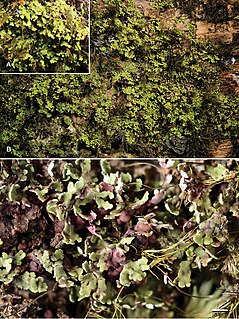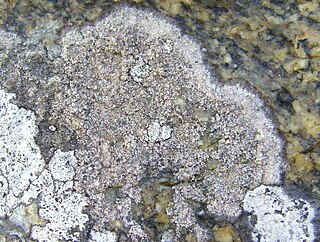Related Research Articles
Irwin M. Brodo is an emeritus scientist at the Canadian Museum of Nature, in Ottawa, Ontario, Canada. He is an authority on the identification and biology of lichens. Irwin Brodo was honored in 1994 with an Acharius Medal presented to him by the International Association for Lichenology.

The Roccellaceae are a family of fungi in the order Arthoniomycetes. Most taxa are lichenized with green algae, although some are lichenicolous, growing on other lichens.
Gymnographopsis is a genus of lichen-forming fungi in the family Graphidaceae. It was circumscribed by American lichenologist Carroll William Dodge in 1967, with Gymnographopsis chilena assigned as the type species.

Krogia is a genus of corticolous lichens in the family Ramalinaceae. It occurs in tropical humid forests and rainforests. The genus was circumscribed by Norwegian lichenologist Einar Timdal in 2002, with Krogia coralloides assigned as the type species.
Jarmania is a genus of lichenized fungi in the family Ramalinaceae. This genus was named in honour of S. Jean Jarman (b.1947), a Tasmanian botanist working in Hobart.

Cresponea is a genus of lichens in the family Roccellaceae. The genus, circumscribed in 1993, contains species that were formerly classified in Lecanactis. Cresponea is widely distributed, but most species are found in tropical and subtropical regions. The genus is named in honor of Spanish lichenologist Ana Crespo.

Bactrospora is a genus of lichen-forming fungi of uncertain familial placement in the order Arthoniales. It was circumscribed by Abramo Bartolommeo Massalongo in 1852.
Gorgadesia is a genus of lichenized fungi in the family Roccellaceae. A monotypic genus, it contains the single species Gorgadesia mira.

Lecanographa is a genus of about 40 species of lichens in the family Lecanographaceae. It was circumscribed in 1994 by José M. Egea and Pilar Torrente, with Lecanographa lyncea as the type species.

Lecanactis is a genus of crustose lichens, commonly called old wood rimmed lichen. The genus was circumscribed in 1855 by German lichenologist Gustav Wilhelm Körber, who assigned Lecanactis abietina as the type species.
Ameliella is a genus of lichenized fungi in the family Lecanoraceae. Described in 2008, the genus contains two species, A. andreaeicola and A. grisea, that were collected from high elevations in the Scottish Highlands. The two species have also been found in single instances in British Columbia and Northern Norway. The generic name is derived from the Greek ameleo, meaning "neglected" or "overlooked"; it was originally intended to be Amelia, which is also the first name of the daughter of one of the authors, but this name had previously been used for another genus and was therefore ineligible for use according to the rules of mycological nomenclature. Ameliella appears to have some similarity with the lichen genus Miriquidica.
Tania is a genus of lichenized fungi in the family Roccellaceae. It has two species. The genus was circumscribed by Maria Egea Fernández, P. Torrente and Harrie Sipman in 1995, with Tania lanosa assigned as the type, and at that time, only species. A second species, T. mohamedii, was added to the genus in 2006. The genus name honours bryologist Benito Ching Tan (1946–2016), who organized the expedition to Mount Kinabalu and collected the type species with Sipman.

Llimonaea is a genus of fungi within the Arthoniales order. The genus has been placed into Opegraphaceae.

William Louis "Bill" Culberson was an American lichenologist.
Josef Hafellner is an Austrian mycologist and lichenologist. He was awarded the Acharius Medal in 2016 for his lifetime contributions to lichenology. Before his retirement, he was a Professor at the Karl-Franzens-Universität in Graz. Hafellner started developing an interest in lichens while he was a student at this institution, studying under Josef Poelt. He earned a master's degree in 1975 and a PhD in 1978, defending a doctoral thesis about the genus Karschia. In 2003, Hafellner received his habilitation. By this time, he had studied with French lichenologist André Bellemère (1927–2014) at Saint-Cloud, where he learned techniques of transmission electron microscopy and how their application in studying asci could be used in lichen systematics. His 1984 work Studien in Richtung einer natürlicheren Gliederung der Sammelfamilien Lecanoraceae und Lecideaceae has been described as "probably the single most influential publication in lichen systematics in the latter half of the 20th century".
Thomas Hawkes Nash III is an American lichenologist. His research is about the biology and ecology of lichens, and the effects of air pollution on plants and lichens. He is known as an authority on the family Parmeliaceae. During his long career at the Arizona State University, he helped develop the lichen herbarium into a world-class collection with over 100,000 specimens representing more than 5000 species. In 2010, the year of his retirement, he was awarded the Acharius Medal for lifetime achievements in lichenology, and the following year had a Festschrift published in his honor.

Opegraphaceae is a family of lichen-forming and lichenicolous fungi in the order Arthoniales. It was originally proposed by German lichenologist Ernst Stizenberger in 1862. It fell into disuse, but was resurrected in a molecular phylogenetic study of the order Arthoniales published in 2010. It now includes taxa that were previously referred to the family Roccellaceae, its sister group.
Henricus (Harrie) Johannes Maria Sipman is a Dutch lichenologist. He specialises in tropical and subtropical lichens, and has authored or co-authored more than 250 scientific publications. He was the curator of the lichen herbarium at the Berlin Botanical Garden and Botanical Museum from 1983 until his retirement in 2010.

Lecanographa dialeuca is a species of saxicolous (rock-dwelling) crustose lichen in the family Roccellaceae. It is found in Cape Verde and Europe.
Claude Roux is a French lichenologist, mycologist and Esperantist. He has co-authored books about the identification of lichens written in Esperanto.
References
- ↑ Wijayawardene, Nalin N.; Hyde, Kevin D.; Lumbsch, H. Thorsten; Liu, Jian Kui; Maharachchikumbura, Sajeewa S. N.; Ekanayaka, Anusha H.; Tian, Qing; Phookamsak, Rungtiwa (2018-01-01). "Outline of Ascomycota: 2017". Fungal Diversity. 88 (1): 167–263. doi:10.1007/s13225-018-0394-8. ISSN 1560-2745.
- ↑ "Myconet". 2009-03-18. Archived from the original on 2009-03-18. Retrieved 2018-03-14.
{{cite web}}: CS1 maint: bot: original URL status unknown (link) - ↑ "Sipmania peltata Egea & Torrente" . Retrieved 27 October 2022.
- ↑ Burkhardt, Lotte (2022). Eine Enzyklopädie zu eponymischen Pflanzennamen [Encyclopedia of eponymic plant names](pdf) (in German). Berlin: Botanic Garden and Botanical Museum, Freie Universität Berlin. doi:10.3372/epolist2022. ISBN 978-3-946292-41-8 . Retrieved January 27, 2022.